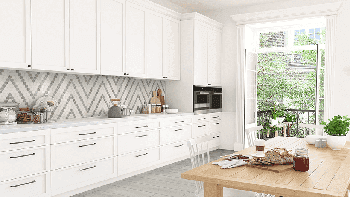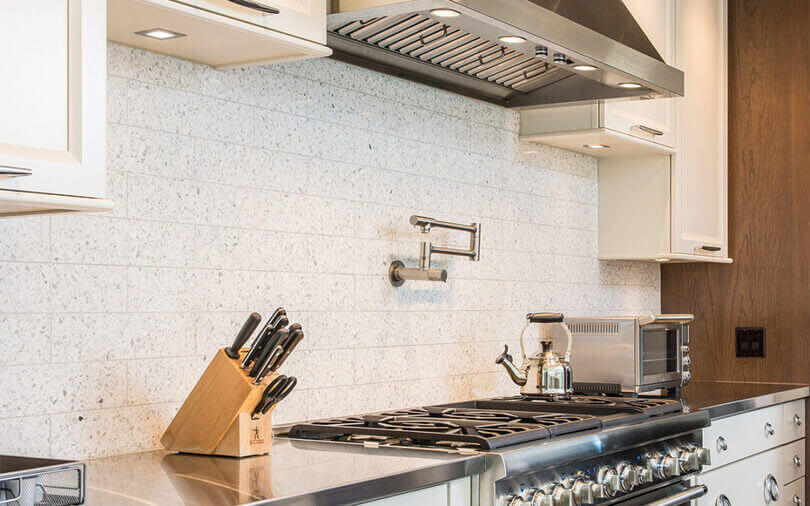
Pot filler, also known as wall-mounted kitchen faucet, is a modern kitchen fixture that is becoming increasingly popular among homeowners. These faucets are designed to be mounted on the wall or backsplash above the stove and have an extendable hose that can be used to fill large pots and pans with water. The question is, do pot fillers add value to the home?
In this article, we will explore the pros and cons of pot fillers and provide insight on factors to consider before making the decision to install one. Read on to decide if pot fillers are really worth the cost.
Quick Read: Generally, installing pot fillers is a sure shot way of adding value to the kitchen and broadly to the home. As per a latest research by Angi, a pot filler can help you gain as much as a 3.2 percent increase in the asking price of your house. So, pot fillers are not only trendy, but are equally practical and valuable, and provide a great return on your investment. Besides the monetary value they add to your property, the convenience and aesthetic appeal of a pot filler is what makes it a truly value-adding kitchen fixture.
Exactly how much value does a pot filler add depends on a variety of factors which we will discuss in detail in this article. So, let’s dive right in.
What is a Pot Filler?
A pot filler is a faucet that is mounted above a stove or cooktop, typically on the wall. Its purpose is to provide a convenient way to fill large pots with water without having to carry them to the sink.
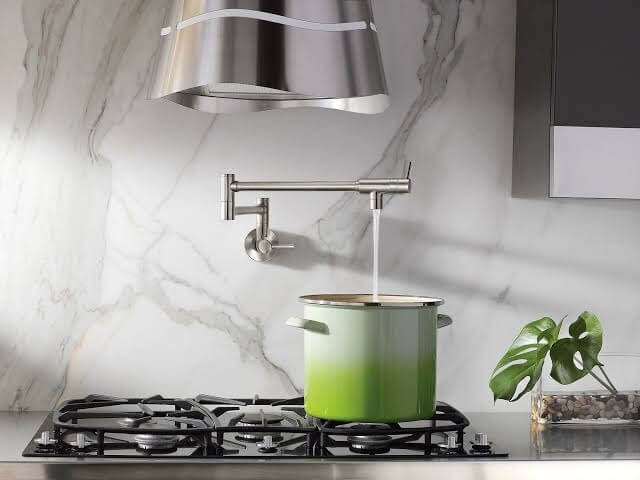
By having the faucet above the stove, it eliminates the need to move heavy pots and pans across the kitchen, reducing the risk of spills and accidents. Additionally, a pot filler can also be used to fill drinking glasses, or a coffee maker, blender, or other small kitchen appliances.
Do Pot Fillers Add Value to the Home?

Does a pot filler add value to the home or not can be a valid concern for many homeowners, especially if they plan on selling the house in near future. Pot fillers can potentially add to the resale value of a house, but it depends on a variety of factors, which we discuss below.
Market Demand
The first factor to consider is the overall market demand for pot fillers. If pot fillers are in high demand in your area, then having one installed in your home could make it more appealing to potential buyers and increase its resale value.
Condition and Quality of Pot Filler
Another factor to consider is the overall condition and quality of the pot filler. If the pot filler is high-end and in excellent condition, it could be seen as a desirable feature that adds value to the home. However, if the pot filler is of lower quality or in poor condition, it may not be viewed as a valuable feature.
That is why we recommend that if you are going to install a pot filler in your kitchen, it would be a wise choice to invest in a good, high-end faucet, because it would eventually add more value to your home.
Do check out our top three picks (on Amazon) below for the best pot fillers which will add most value to your kitchen.
Best Brushed Gold Finish |
Best Antique Brass Finish |
Best Brushed Nickel Finish |
Kitchen Layout and Design
Additionally, the kitchen layout and overall design of the home should be considered while deciding whether a pot filler will add significant value or not. If the pot filler complements the overall design of the kitchen and the home, it could be seen as a desirable and trendy fixture, hence adding value to the home. However, if the pot filler is not well-integrated with the design of the home, it may not be viewed as valuable by potential buyers.
Buyers’ Preferences
It is worth noting that pot fillers are not as common as other kitchen appliances such as ovens or refrigerators, and some buyers may not be familiar with their functionality. Therefore, a pot filler may not have a significantly high impact on the resale value of a house, but could surely be seen as a nice luxury feature that adds some value.
The Pros of Pot Fillers
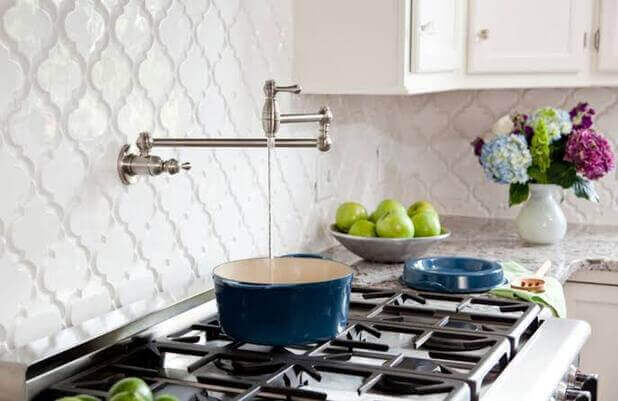
Pot fillers are much more than just a trendy, luxury fixture in the kitchen and have a number of advantages to their credit.
Convenience and ease of use
One of the main advantages of pot fillers is their convenience and ease of use. Instead of having to carry heavy pots and pans to the sink to fill them with water, pot fillers allow you to fill them right on the stove.
Time-saving
Pot fillers can save your precious time in the kitchen in two ways. First, you don’t need frequent trips to the sink to fill the pots with water. And second, the rate of water flow from a pot filler is roughly four gallons per minute, which is more than double than that from a regular sink faucet. So, with a pot filler, you can get a faster fill and get to cooking sooner.
Relieve straining
Pot fillers can also make it easier for those with mobility issues to fill large pots. As for people with back problems or injuries, or who have undergone spinal surgeries of any kind, a pot filler is a must have. This is because lifting and carrying water-filled pots can put immense strain on their back and aggravate their condition.
No more spills and mess
While carrying water-filled pots from the sink to the stove, some water can get spilled or splashed on the counters or floor. This is not only an extra mess to clean but can even damage your kitchen. For instance, if you have wooden flooring or counter lamination, even a small amount of water can warp the wood. A pot filler relieves you of this worry as well.
Aesthetically pleasing
Another advantage of pot fillers is that they can be a great addition to the aesthetics of a kitchen. Many pot fillers on the market today come in a variety of finishes, such as stainless steel (see on Amazon) and oil-rubbed bronze (see on Amazon), and can add a touch of elegance to the kitchen.
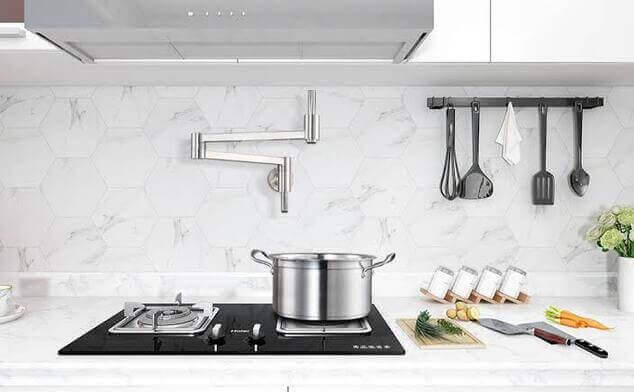
The Cons of Pot Fillers
Despite the many advantages of pot fillers, there are also a few drawbacks to consider.
Cost
The main disadvantage is cost. Pot fillers can be quite expensive, ranging from hundreds (see on Amazon) to even thousands (see on Amazon) of dollars, and the cost of installation can add even more to the overall expense.
Extra water line installation
In most cases, you’ll need to run a water line from the nearest water source in your kitchen (like the sink) to the back of the stove where the pot filler will be installed. This obviously demands some demolition, and restoring the tiles or backsplash afterwards. So, the installation is not only an extra cost incurred, but also quite a hassle.
- Tip: We recommend adding a pot filler while you are building a new house or doing some renovations to the kitchen.
Leakage and drainage
Since pot filler faucets are installed over a stovetop, they do not have a drainage system. So even the slightest of leaks can be a major problem. That is why you should carefully pick a high quality pot filler faucet which gives you more control in this regard, like multiple shut off valves.
Need regular cleanup
With a pot filler installed over stovetop and all that oil and sauces bubbling and splattering, get ready for cleaning the faucet on a regular basis to preserve it in it’s best form.
Limited functionality
Some people may find that the limited functionality of pot fillers does not justify the cost. However, it is a matter of personal preferences, and if placed and used appropriately, a pot filler can even function as a secondary faucet in a busy kitchen e.g. to fill drinking glasses.
Space constraints
There is limited space between the cooktop and the range hood, so it is absolutely necessary to determine the correct height for pot filler installation in advance.
Additionally, pot fillers may not be suitable for all kitchen layouts, and may not work well with certain stovetops. For example, if you have a cooking range with a lid, you cannot possibly install a pot filler directly above the range.
- Tip: In such cases you can consider side placement for your pot filler, i.e. above the counter, from where the faucet arm can extend to the burners.

Factors to Consider Before Installing a Pot Filler
Before deciding to install a pot filler, there are several factors to consider.
Kitchen layout
As mentioned earlier, pot fillers may not be suitable for all kitchen layouts and may not work well with certain stovetops (like a cooking range with lid).
Budget
Additionally, consider your budget. Pot fillers can be quite expensive, and the cost of installation can add even more to the overall expense.
Personal preferences
Do you do a lot of cooking and entertaining? If so, a pot filler may be a great addition to your kitchen. On the other hand, if you don’t cook frequently, a pot filler may not be worth the cost.
Final Thoughts – Do Pot Fillers Add Value?
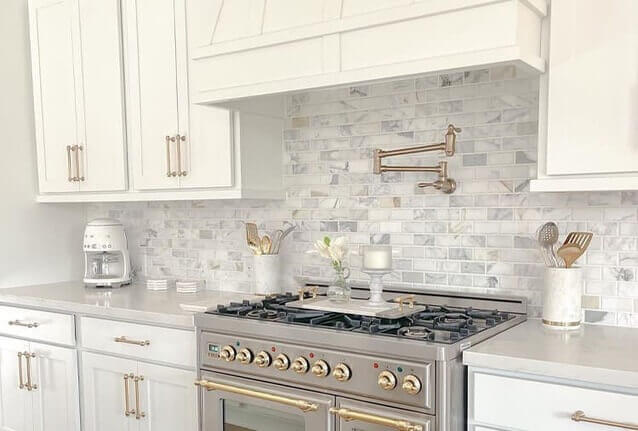
Overall, pot fillers can add value to a home by providing convenience and increasing the aesthetic appeal of the kitchen. However, it is important to weigh their pros and cons and consider factors such as cost, functionality and space before deciding to install one.
From a seller’s perspective, pot fillers can potentially add to the resale value of a house, but it depends on a variety of factors, including market demand, condition and quality of the pot filler, kitchen layout and overall design of the home, and the buyers’ preferences. It is important to consider how a pot filler fits into the overall design and functionality of the home before making a decision to install one with the intention of increasing the resale value.
Frequently Asked Questions
If you have any other questions or would like to share something, please feel free to comment below. I would love to hear from you.
You may also like: 7 Best Microwave Toaster Oven Combos in 2023






